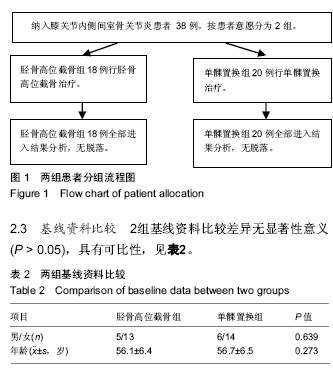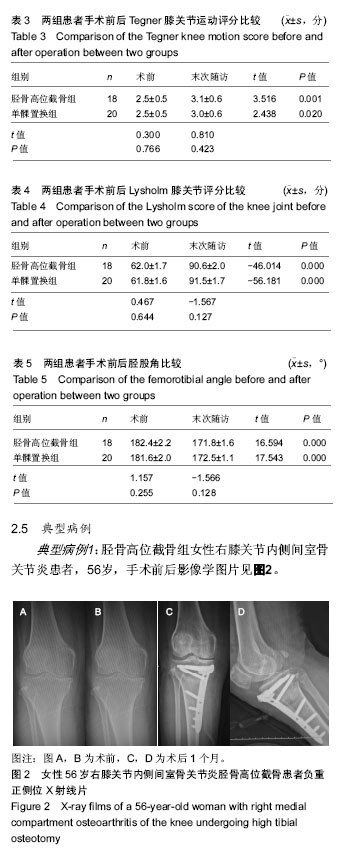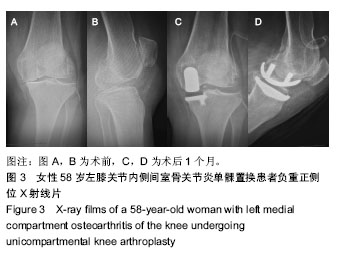| [1] 安雪军,王小健.膝骨关节炎两种截骨术的疗效比较[J].中国药物与临床, 2015,15(11):1641-1642.[2] 尚延春,张海英,张江涛,等.胫骨高位截骨手术治疗膝内翻型骨性关节炎长期随访分析.中国矫形外科杂志,2007,15(13): 973-975.[3] 祁昕征,张家铭,谭传明.从生物力学角度评价单髁置换术与腓骨截骨术[J]. 医用生物力学,2015,30(6):479-487.[4] 孔令俊,邓强,赵军,等.关节镜下有限清理术治疗膝骨性关节炎的疗效[J]甘肃医药, 2013, 32(4): 296-297.[5] Dunn AS, Petterson SC, Plancher KD. Unicondylar knee arthroplasty. Clin Sports Med. 2014;33(1):87-104.[6] Lim JW, Cousins GR, Clift BA, et al. Oxford unicompartmental knee arthro plasty versus age and gender matched total knee arthroplasty functional outcome and survivorship analysis. J Arthroplasty.2014; 29(9):1779-1783.[7] 袁毅,马川,黄家俊.膝关节骨性关节炎的治疗进展[J].西部医学, 2011, 23(8):1600-1602. [8] 刘晓东,蔡珉巍,涂意辉.微创单髁置换术治疗膝关节内侧间室骨性关节炎的初步临床报告[J].中国矫形外科杂志, 2010,18(7):548-552.[9] Longo UG, Loppini M, Trovato U, et al. No difference between unicompartmental versus total knee arthroplasty for the management of medial osteoarthtritis of the knee in the same patient: a systematic review and pooling data analysis. Br Med Bull. 2015;114(1):65-73.[10] Costa CR, Johnson AJ, Mont MA, et al. Unicompartmental and total knee arthroplasty in the same patient. J Knee Surg. 2011; 24(4):273-278. [11] Laurencin CT, Zelicof SB, Scott RD, et al. Unicompartmental versus total knee arthroplasty in the same patient.A comparative study. Clin Orthop Relat Res. 1991;273(2):151-156. [12] Nwachukwu BU, McCormick FM, Schairer WW, et al. Unicompartmental knee arthroplasty versus high tibial osteotomy: United States practice patterns for the surgical treatment of unicompartmental arthritis. J Arthroplasty. 2014;29(8): 1586-1589.[13] Jones GG, Kotti M,Wiik AV,et al. Gait comparison of unicompartmental and total knee arthroplasties with healthy controls. Bone Joint J. 2016; 98-B(10 Suppl B):16-21. [14] Maduekwe UI, Zywiel MG, Bonutti PM, et al. Scientific evidence for the use of modern unicompartmental knee arthroplasty. Expert Rev Med Devices. 2010;7(2):219-239. [15] Squire MW,Callaghan JJ,Goetz DD,et al. Unicompartmental knee replacement.A minimum 15 year follow up study.Clin Orthop Relat Res. 1999;(367):61-72.[16] Wong T, Wang CJ, Wang JW, et al. Functional outcomes of uni knee arthroplasty for medial compartment knee arthropathy in asian patients. Biomed J. 2014; 37(6): 406-410. [17] Soohood NF,Sharifi H,Kominski G,et al. Costefeetiveness analysis of unicompartmental knee arthroplasty as an alternative to total knee arthroplasty for unicompartmental osteoarthritis. J Bone Joint Surg Am. 2006;88(9):1975-1982. [18] Maduekwe UI, Zywiel MG, Bonutti PM, et al. Scientific evidence for the use of modern unicompartmental knee arthroplasty. Expert Rev Med Devices. 2010;7(2):219-239. [19] 刘志宏,张炅,何川,等.活动平台全膝关节假体和单髁膝关节假体置换术后的步态对比分析[J].中华关节外科杂志(电子版), 2017,11(1): 17-23. [20] Pornrattanamaneewong C, Numkanisorn S, Chareancholvanich K, et al. A retrospective analysis of medial opening wedge hightibialosteotomy forvarus osteoarthritic knee. Indian J Orthop. 2012;46(4): 45.[21] Rossi R, Bonasia DE, Amendola A, et al. The role of high tibial osteotomy in the varus knee. J Am Acad Orthop Surg. 2011;19(10): 590-599.[22] 黄将来.胫骨高位截骨术治疗内翻型膝骨性关节炎的效果分析[J].河南医学研究,2016,25(6):1042-1043.[23] 熊福军,贺西京,冯宏伟,等.关节镜下胫骨高位截骨治疗早期膝骨关节炎并内翻畸形疗效观察[J].现代中西医结合杂志, 2014,23(4):389-390.[24] Spahn G, Hofmann GO, von Engelhardt LV, et al. The impact of a high tibial valgus osteotomy and unicondylar medial arthroplasty on the treatment for knee osteoarthritis: a meta-analysis. Knee Surg Sports Traumatol Arthrosc. 2013;21(1): 96-112.[25] 孔令俊,邓强,赵军,等. 关节镜下有限清理术治疗膝骨性关节炎的疗效[J]. 甘肃医药, 2013, 32(4): 296-297.[26] Liu JS. Combined closing- wedge high tibial osteotomy with arthroscopy for varus knee and medial compartment osteoar?thritis: clinical results at a minimum follow-up for five years. Zhongguo Gu Shang. 2013;26(9): 748-752.[27] Fu D, Li G, Chen K, et al. Comparison of high tibial osteotomy and unicompartmental knee arthroplasty in the treatment of unicompartmental osteoarthritis: a meta analysis. J Arthroplasty. 2013;28(5): 759-765.[28] Schindler OS, Scott WN, Scuderi GR. The practice of unicompartmental knee arthroplasty in the United Kingdom. J Orthop Surg (Hong Kong). 2010;8(3):312-319. [29] Dettoni F, Bonasia DE, Castoldi F, et al. High tibial osteotomy versus unicompartmental knee arthroplasty for medial compartment arthrosis of the knee a review of the literature. Iowa Orthop J. 2010; 30: 131-140.[30] 杨波,姜鑫.单髁置换术与胫骨高位截骨术治疗膝关节内侧间室骨关节炎的近期疗效比较[J]. 中国修复重建外科杂志,2015, 29 (5): 548-552. |
.jpg)



.jpg)
.jpg)